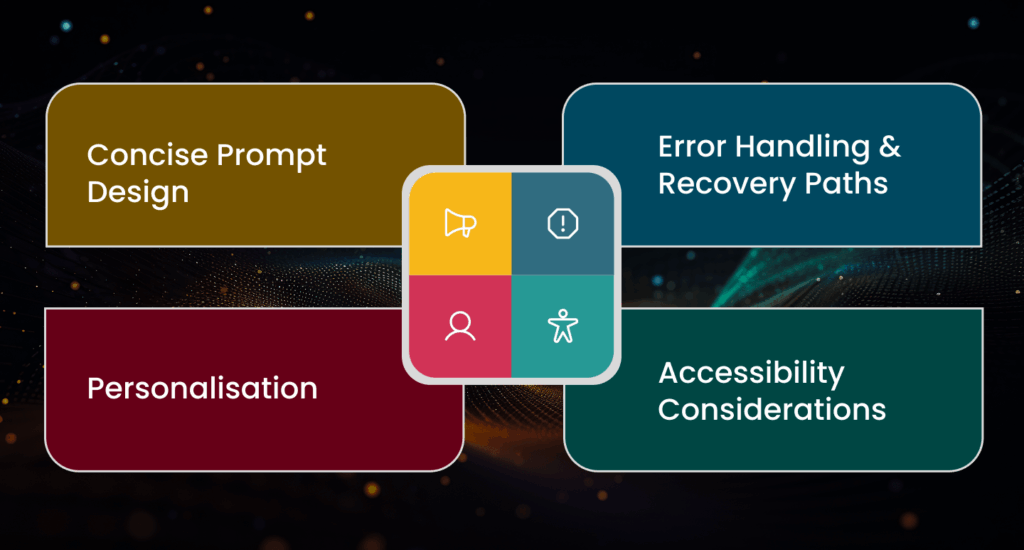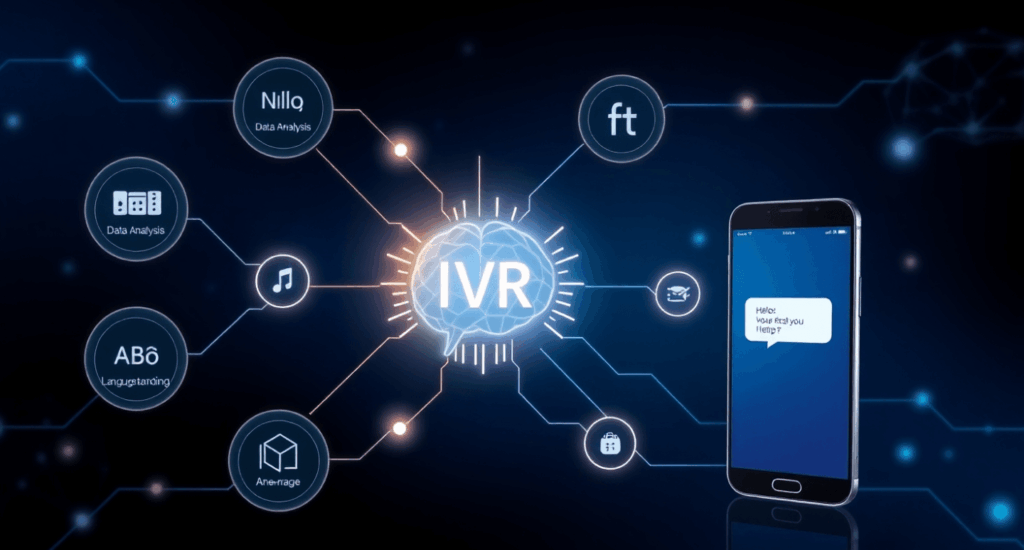|
Getting your Trinity Audio player ready...
|
Executive Overview & Business Benefits
By the end of 2025, the interactive voice response (IVR) system of the intelligent variety will prove vital for organisations trying to provide better service to their customers at lower operational expenses. The new IVR systems use AI to understand natural language, direct calls based on context, and analyse data in real-time, allowing for smooth interactions that feel almost human, unlike the old menu-based IVRs that were inflexible and not user-friendly.
Reduction of Average Handle Time (AHT) by 40% further qualifies IVR technology to resolve issues faster and provide agents the time needed to work on more complex issues. Self-service containment rates are often as high as 80%, meaning that the majority of queries become resolved without intervention by the live agent. This results in significant cost savings because call centres spend less on resources while managing high volumes of calls.
Moreover, intelligent IVR solutions can provide support 24/7, thereby ensuring that customers can get help at any time, regardless of whether agents are available or not. Businesses also benefit from scalability, as these systems are capable of managing seasonal call spikes instead of needing additional human resources.
Esferasoft has been a leader in telephony and AI communication solutions since the inception of its IVR applications, helping its clients in telecom, finance, and retail with tailored, efficient, and secure customer interactions, which significantly contribute to improving customer satisfaction (CSAT) and operational efficiency.
Core Functional Modules & Feature Prioritisation
One of the significant modular fundamentals of a successful IVR system is a carefully thought-out set of impact modules that facilitate caller interaction and optimise its business performance. Concerning features, the right ones will ensure that they can start contributing to the business from “day one”:

- Speech Recognition & DTMF Input: Intelligent IVR systems can recognise speech and corresponding numbers either through Automatic Speech Recognition (ASR) or DTMF keypad inputs. The case of obtaining the best engine, such as Google Speech-to-Text or Nuance Recogniser, should be made for accuracy in nasty conditions with many accents.
- Dynamic Call Flow Designer: It is thus the simplest element for designing and easily editing workflows even for the most nontechnical individuals, since it offers a visual drag-and-drop interface. This application provides almost immediate iterations and optimisations without consuming resources on development cycles.
- Text-to-Speech Variations: The ability to have a natural-sounding TTS voice in multiple languages makes it easier for customers to access the service and feels more comfortable. These businesses can then provide seamless services to the international markets.
- Automated Self-Service Transactions: The automated functions associated with billing enquiries, payment processing, or scheduling appointments save the agents time, speeding up response and reducing the dependency on agents.
- Call Routing & Escalations: For its requirement, skill-based routing directs a patron towards the most qualified source via an escalation method or through the priority queue for immediate cases and VIPs.
- Analytics & Reporting: The analytics become accessible through a real-time dashboard that describes statistical calls directed to completion, menu navigation accuracy, drop-off points, and customer satisfaction to pilot a data-led change.
With its core modules implemented in a phased manner, organisations can offer their customers a highly functional, scalable IVR system, which is ready to comply with an increasing customer expectation.
Telephony & Integration Architecture
The process of designing a complete telephony architecture should focus on scalability, security, and interoperability with both current and future communication and data systems to create a robust IVR application. It should have an assured, reliable voice, real-time data access enabled, and be environment agnostic about infrastructure.
- SIP Trunking versus PSTN Gateways: SIP trunking provides a highly cost-effective and flexible solution for some VoIP telephone systems. PSTN gateways may be present in a few remaining areas that have not fully switched over to VoIP, but they tend to be expensive and require high maintenance. Many organisations are adopting hybrid architectures to make them more compliant.
- Integration with CRM and Contact Centre Platforms: Integrating CRM systems with IVR solutions (Salesforce, Zendesk, or HubSpot) and contact centre platforms (Genesys, Five9) allows agents to access real-time information that helps them solve customer issues more quickly and achieve first-call resolution more often.
- API-First Microservices: Back-end integrations are done either through RESTful APIs or gRPC so that their services can be hosted modularly for reuse, meaning features such as balance enquiries, order tracking, and real-time scheduling of appointments can be enabled. When business needs change, microservices offer flexibility and scalability.
- Database and Session Management: IVR systems should implement excellent session management to actually maintain call context over many steps of transactions. Stateful designs would be really good for more complicated workflows (for example, loan applications), while stateless flows are more efficient in their handling of a large number of simple queries.
- Cloud Deployment vs. On-Premise: Rapid deployment and availability enable on-demand scaling, with managed infrastructure serving as one of the value propositions that cloud-based IVR solutions provide to companies seeking agility. However, in-house installs are preferable to businesses that have high data residency requirements, regulatory compliance, or ultralow latency.
With telephony engineering and cloud integration expertise from Esferasoft, clients are ensured to have architectures that boast of 99.99% uptime, can support millions of concurrent calls, and provide secure and reliable experiences for customers.
AI & NLP Enhancements
The fields of artificial intelligence (AI) and natural language processing (NLP) help IVR systems change from simple menu-based tools to interactive conversation systems that can understand and respond like humans.
- Intent Classifications: AI-powered modern models using BERT or GPT-like NLP engines enable the IVR system to understand what callers want from their natural speech so that the interactions can flow smoothly and naturally.
- Entity Extraction: AI-led Entity Recognition captures important information, such as account numbers, email addresses, or dates, straight out of the spoken responses, thus avoiding monotonous prompts and reducing friction.
- Context Management: Modern IVR systems are capable of conducting multi-turn conversations while remembering things mentioned earlier in the call. This enables callers to switch topics or refer to previously shared information without starting afresh.
- Sentiment Analysis: With real-time emotion detection, a unit assesses the extent of caller’s frustration or satisfaction. Negative sentiments are automatically escalated to a live agent to mitigate churn and to improve the customer experience.
Esferasoft’s AI-driven IVR applications provide personalised, context-aware customer interactions that greatly enhance self-service success rates and overall customer satisfaction.
User Experience & Voice UX Design

The success of any IVR depends on the user’s experience. Badly designed menus cause customer frustrations and increased rates of abandonment. Esferasoft works on human-centred voice UX designs to ensure intuitive, simple, stress-free interactions.
- Concise Prompt Design: A prompt is very short, clear, and has no redundant lobby of jargon. Menu depth to be limited to 3 or fewer levels deep inhibits decision fatigue and will be faster in resolution.
- Error Handling & Recovery Paths: Proactive error management has a clear set of fallback alternatives when something goes wrong during the recognition phase. Features such as “Did you mean …?” or similar quick transfers to a live representative will not totally relieve user frustration.
- Personalisation: Use the name of the caller, as given by the CRM, and pitch different menu options according to what has transpired in the past or according to customer status (say, overdue accounts will show payment options).
- Accessibility Considerations: Diversity in accent, language, and diverse speech impairments is always a plus for inclusivity. Adjustable speed of speech and use of DTMF alternatives ensure everyone can access the service.
Following this, businesses can enhance their NPS (Net Promoter Score) and build more favourable customer experiences. Esferasoft’s User Experience experts ensure that every interaction done via an IVR feels natural, effective, and aligned with what customers expect.
Compliance & Security Considerations
It requires strict security as well as compliance in handling sensitive customer information over IVR channels. Esferasoft contributes to industry practices for securing data and ensuring compliance with the following regulations:
- PCI DSS for Payments: Secure DTMF masking ensures that sensitive card information is neither saved in call recordings nor exposed to agents during compliance for the payment process.
- GDPR & Privacy: The IVR system must seek the recording consent for calls, as well as apply the retention policy according to GDPR guidelines and other laws applicable in different regions.
- Secure Communication Channels: Internal H.323 calls need to be protected by the combination of TLS and SRTP.
- Audit Trails and Compliance Logs: These are secure records of IVR interactions that help make the service clear and accountable for audits and inspections.
With these controls in place, companies will feel totally safe in managing customers’ payments and storing personal data with no worries of having to comply with many jurisdictions.
Pilot Program & Proof-of-Concept
We need a structured pilot program to demonstrate the IVR solution’s effectiveness prior to its rollout.
- Pilot Scope: Identify one specific use case with significant impact, such as billing enquiries or appointment scheduling, to evaluate performance and avoid spreading resources too thin.
- Success Metrics: Success factors would include tracking containment rates, call drop percentages, average handle times, and customer feedback.
- Timeline & Resources: Typically, a Proof of Concept (PoC) would last about 4–6 weeks, which includes activities like planning, configuring settings, testing, and limited live deployment.
- Stakeholder Alignment: During the course of the pilot, we brought the IT, customer service, and compliance teams on board to satisfy all technical and operational needs.
- Scaling Strategy: We would replicate and scale successful post-pilot processes across all call flows, backed by adequate training and documentation.
Our team guides businesses through every step of the pilot process, ensuring actionable insights and a smooth transition to enterprise-wide deployment.
ROI Modeling & Pricing Strategies

Understanding the ROI is fundamental to the implementation of an IVR system. Esferasoft’s options offer flexible pricing that maximises value through transparent cost structures.
- Subscription or Usage-Based Pricing: Companies can choose to pay either fixed monthly fees or variable fees based on call minutes or active sessions, putting costs in line with actual usage.
- Value-Based Pricing: For high-impact solutions, fees can be directly pegged to measurable outcomes, such as reduction in agent costs or increasing customer satisfaction scores.
- Implementation Fees: The one-time setup fee will cover solution design, custom IVR scripts, integration, and deployment.
- Total Cost of Ownership: Continuous expenses include cloud infrastructure, AI API usage, system maintenance, and technical support for 24/7. These cloud solutions help greatly reduce infrastructure costs compared to traditional setups.
- Payback Period Examples: Because of reduced agent workload, enhanced first-call resolution, and higher self-service adoption rate, payback is usually complete for a business within 3 to 6 months.
With transparent pricing and clear ROI models, we allow organisations to see the financial benefits upfront so they can confidently invest in smart IVR systems.
Risk Mitigation & SLA Guarantees
Any IVR deployment is all about reliability and performance. Therefore, we have taken various advanced measures to ensure uninterrupted service delivery:
- High Availability Architecture: With backup servers and data centres in different locations, this setup ensures that services continue without interruption, even during outages or maintenance.
- Performance SLAs: Esferasoft promises to keep its clients happy by way of ironclad service-level agreements covering aspects ranging from uptime and latency to speech recognition accuracy.
- Fallback to Agents: In cases where the IVR is faced with any errors, or systems are disrupted, it will initiate automated failover protocols to actually clump in live agents.
- Continuous Monitoring & Alerts: Proactive monitoring detects, almost in real time, any anomalies in call queues and system errors, allowing for immediate corrective actions.
These checks ensure minimum downtime and loss of customer confidence, and this guarantees predictable, high-quality IVR performance.
Why Esferasoft? Expertise in IVR & AI
EsferaSoft is a trustworthy and multifaceted partner for those looking to develop next-generation IVR solutions. Below are some of EsferaSoft’s key strengths.
- Track Record: Communicated for the last few years about projects of IVR for some of the world’s telecom, banking, and retail giants.
- In-House Resources: We work with a multidisciplinary team composed of AI engineers, telephony architects, and UX specialists who cover the entire end-to-end solution.
- AI Innovations: Our unmatched IVR solutions incorporate advanced NLP and machine-learning technologies to create conversational interfaces that can outperform traditional methods.
- End-to-End Support: This includes gathering requirements, designing solutions, installing, monitoring, and providing post-launch support 24/7.
- Client Success: Esferasoft’s intelligent IVR solution is reported to have resulted in cost savings, an increase in CSAT scores, and improved operational efficiency for its clients.
With us, businesses gain a partner committed to transforming customer engagement through innovative voice automation.
Start Your Intelligent IVR Journey Today

Change your customer service with an AI-driven IVR solution tailored for your business requirements. We give you a complimentary IVR health check and an assessment of ROI so that you can help discover the opportunities that can be automated and cost-cutting.
Speak with our experts today at +91 772-3000-038 to learn more about a customised pilot programme that can bring about noticeable improvements in just a few weeks.
Spaces are going fast for Q4 2025 pilots, so act now to claim your place and start building the intelligent IVR system your customers deserve.
Contact Esferasoft to start your journey toward smarter, scalable, and customer-focused voice solutions.

